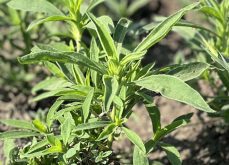While chemistries out there continue to work for most farmers, the days of spraying their way out of volunteer canola issues are receding in the rearview mirror.
“I’m not going to say that herbicides don’t work because there are quite a few herbicide options still to manage volunteer canola,” says Charles Geddes, a research scientist for Agriculture and Agri-Food Canada at Lethbridge. “But when we talk about weed management, it’s really all about integrating those herbicide programs with other cultural factors.”
Geddes speaks from experience: he currently leads the AAFC Weed Ecology and Cropping Systems Research program, which monitors herbicide-resistant weeds across the Prairies. And in the early 2010s, his PhD work at the University of Manitoba was specifically focused on controlling volunteer canola in soybeans.
Read Also

Claas brings 1000 Series SP forage harvesters to Canada
In mid-August, Claas unveiled its new line of Jaguar forage harvesters at an event in Visalia, California, deep in the heart of that state’s dairy region.
Volunteer canola was a big issue at the time — especially in Manitoba, where soybean acres were on the rise because short-season cultivars had emerged that could thrive in the province. The challenge arose because these new soybean varieties, like canola, were genetically modified to be resistant to the same herbicides.
“Farmers who had already been growing canola were starting to adopt soybeans, and volunteer canola was coming back as a difficult-to-control weed in those soybean crops,” Geddes says.
As a result, a lot of emphasis was placed on developing strategies to manage the problem — and one of the strategies Geddes looked at was targeting the seed bank.
“The easiest way to do that is through some form of physical disturbance, whether it’s tillage or harrowing,” he says.
Anyone who grows canola knows there will be a certain amount of seed loss. Whether it’s seed being lost ahead of the combine, at the header, or being blown out of the back of the combine because of the way the combine is set, some seed loss is to be expected.
Geddes notes surveys on the Prairies revealed seed losses of up to 5,000 seeds per square metre. Canola seeds have a unique ability to enter ‘secondary dormancy’ under the right conditions, such as warmer temperatures and dry soil. This dormancy allows the seeds to persist longer in the soil seed bank.
“We can typically see volunteer canola sticking around for at least two to three years,” he says.
Fall harrowing
So, beginning in 2013, Geddes, along with his research partner and study co-author Rob Gulden, set up research plots across southern Manitoba, at Carman, Howden and Melita, to test the effectiveness of soil disturbance on the volunteer canola seed bank.
They studied how both the timing and type of soil disturbance impacted the seed bank. In terms of soil disturbance, they looked at harrowing and tandem disc compared to a zero-till control. In terms of timing, they ran the two soil disturbance methods immediately following harvest, one month after harvest, and the following year, just before spring seeding.
“What we found was that if you can disturb that soil as soon after canola harvest as possible, it goes a long way to helping to deplete the seed bank going into the next growing season,” Geddes says.
The research found early soil disturbance enhanced seed-to-soil contact for seeds lost during harvest. With sufficient moisture, the seeds germinated, and winterkill did the rest. The results were a little less pronounced a month after harvest, and negligible pre-seeding.
The type of soil disturbance didn’t seem to matter. Both methods performed equally well compared with the no-till control.
READ MORE: How to keep last year’s canola out of your beans
“What that means is that even if we’re in more of a no-till or a min-till environment, we can get away with a bit of a lighter disturbance,” said Geddes. “It’s just enough to promote that seed-to-soil contact in the fall.”
Published in 2017, Geddes’ work was one of the earlier studies to look down these paths for control of volunteer canola in soybeans — but its findings still stand today as farmers continue to grapple with volunteers.
The changing face of volunteer management
For the past 20 years, volunteer canola has risen in the rankings of problem weeds. Geddes says recent surveys have placed volunteer canola in the top two or three most abundant weeds in the Prairie provinces.
“It’s different than some of the other herbicide-resistant weeds because volunteer canola resistance was actually purposefully selected through genetic modification,” he says. And while those genetics have improved weed management in canola production, because its seeds can persist in the soil for so long, they tend to come back to haunt farmers.

Crop rotation and sequencing
As a result, Geddes says crop rotation has become a critical tool in volunteer canola management.
“If we’re growing tight crop rotations that are only two to three years in length, it’s not a surprise that voluntary canola will be one of the more abundant weeds to manage,” he says. “So having enough of those crops between canola rotations to manage those volunteer canola populations is quite important.”
As mentioned, few, if any, farmers think chemistry alone will help them control volunteer canola.
“With a herbicide-only program, combined with short or non-diverse rotations, it’s pretty difficult to keep the issue under control,” Geddes says. “If they are practicing tight rotations, they quickly learn that the issue can show up, and you really do need those break crops in there to manage it effectively.”
The order in which to plant rotations is also important. For example, with voluntary canola being particularly difficult to manage in soybeans, it would make sense to put a cereal between canola and soybean crops, so you have at least a one-year break.
“Those volunteers will be reduced going into your soybean crop already, because you’ve had enough time since your last canola crop.”
Crowd it out
Because canola was bred to be a relatively competitive crop, voluntary canola acts as a relatively competitive weed. So, in terms of cultural weed management, it makes the most sense to apply those strategies early in the growing season.
“It does get up and out of the ground quickly,” Geddes says. “So it’s really that early season they want to target to get as competitive a crop as early as possible.”
















